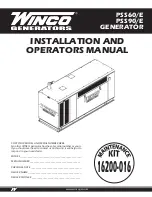
13
OPM-117/B
DC INTERCONNECTIONS TO ATS
Two control wires are required between the ATS panel
and the generator control terminal box. Depending on the
distance, 14 and 16 gauge stranded wire should be used.
These wires should be labeled S1 and S23.
WARNING:
Be sure engine generator is in the OFF position before you
make any DC interconnections.
ASCO 185 UL SWITCH
Your DC connection points in the ASCO 185 UL ATS are on
the terminal block on the bottom of the controller in the
lower left hand corner of the ATS panel. The terminal block
(TB7) is numbered 1 through 9. These terminals will accept
# 22 - # 14 AWG stranded wire. It is recommended that you
use # 16 AWG for distances up to 200 feet. You need to run
two (2) wires from the engine generator set to the transfer
switch. You will be using terminals 4 and 5, wire Start # 23
will connect to terminal # 5 and wire Battery Negative #
1 will connect to terminal # 4. See the following table and
illustration.
Your DC connection points in the ASCO 185 ATS are
terminals “4” and “5” on the interface terminal block. As this
is a “DRY” unpowered contract set it set, it makes difference
which lead (battery negative #1 or start #23) connect to
which terminal.
ASCO 300 UL SWITCH
When Normal
Source Fails
Terminals On
Transfer Switch
Contact Closes
TB1 and TB2
Contact Opens
TB1 and TB3
Engine start and
auxiliary circuit
terminal block TB
located on 3ATS
&3NTS transfer
switch.
STARTING PROCEDURE
CONTROL LAYOUT
STOP/RESET - This button places the module into its Stop/
Reset mode. This will clear any alarm conditions for which
the triggering criteria have been removed. The fuel supply
de-energizes and the engine comes to a standstill. Should a
remote start signal be present while operating in this mode,
a remote start WILL NOT occur.
MANUAL MODE - This button places the module into its
Manual Mode. Once in Manual Mode, the model responds
to the Start button to start the generator and run it off load.
START - Pressing this button from STOP/RESET will start the
engine and run the load.
AUTO MODE - This button places the module into its Auto
Mode. This mode allows the module to control the function
of the generator automatically.
ALARM/LAMP TEST - This button silences the audible alarm
in the controller, deactivates the Audible Alarm output (if
configured) and illuminates all of the LEDs on the module’s
face as a lamp test function.
MENU NAVIGATION - Used for navigating the
instrumentation, event log, and configuration screens.
A small rocker switch is located on the
underside of the engine control cabinet.
On gaseous models, the engine timing is
controlled by the ECU on the engine and you
need to tell it what fuel you want to operate
on; LP or NG.
On diesel models, this switch has been
disconnected and will do nothing.
PROTECTIONS
When an alarm is present, the common alarm LED if
configures will illuminate. The LCD display will show an icon
to indicate the failure.
WARNINGS
Warnings are non-critical alarm conditions and do not
affect the operation of the generator system, they serve to
draw the operator’s attention to an undesirable condition.
Warning alarms are self-resetting when the fault condition
is removed. The icon will appear steady in the display.
SHUTDOWN
Shutdowns are critical alarm conditions that stop the
engine and draw the operator’s attention to an undesirable
condition. Shutdown alarms are latching. The fault must be
removed and the STOP/RESET button pressed to reset the
module. The icon will be flashing in the display.






































